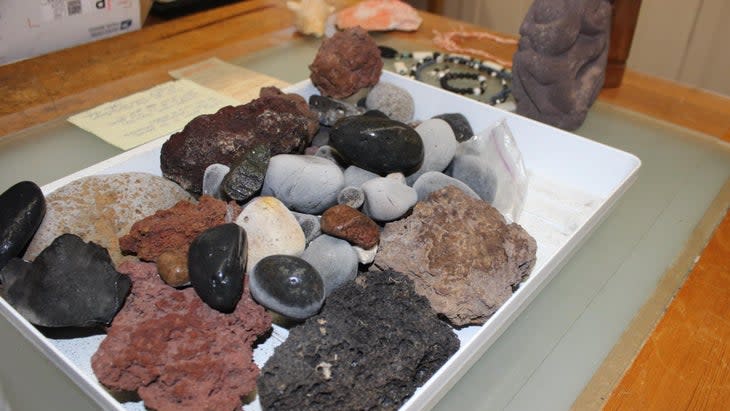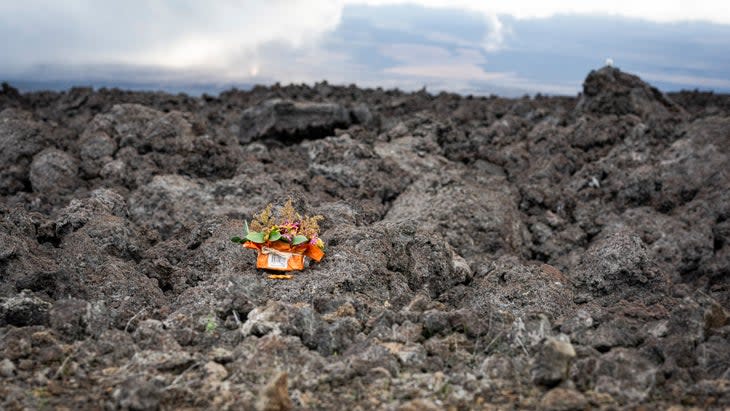Let’s All Agree to Stop Stealing Hawaii’s Lava Rocks
This article originally appeared on Outside
When visiting a National Park--or any wilderness area, for that matter--you're not supposed to take anything home with you. The much-repeated mantra Leave No Trace means you don't pick wildflowers, capture any critters to keep as pets, or tuck any shiny stones into your pockets.
Alas, visitors to Hawaii's Haleakala and Volcanoes National Parks have, for decades, disregarded this simple request and have stolen lava rocks. The pilfering of these stones has then caused a bizarre dynamic involving a mythical lore and and the U.S. Postal Service.
Christine Hitt at SFGate reported this week that every year, hundreds of people mail their "borrowed" lava rocks back to both parks. In 2013 alone, officials at Haleakala received 1,275 rocks in the mail. Park officials are sick of it.
"We would love for people just to stop taking stuff and then also please just stop mailing us stuff," Heather Whitesides, a public affairs officer for Haleakala National Park, told SFGate.
I wish it were people's guilt over LNT that pushed them to mail the rocks back, but many seem to be motivated by an entirely different emotion: fear. Specifically, they are afraid of a supposed curse involving the Hawaiian goddess Pele. According to cultural history, Pele is the creator of the Hawaiian Islands, and is embodied in all of the island's volcanoes, black sand beaches, and yes, lava rocks. As the legend goes, anyone who steals a rock from Hawaii will suffer back luck. Yep--it's been written about on the Internet, so it must be true--right?

Scared tourists have mailed rocks back to Hawaii for decades, and the practice causes a real headache for the staffers at Hawaii's two national parks. Foreign stones may carry bacteria and diseases, and officials are wary of contaminating flora and fauna by just tossing them back into the park. In a 2017 Facebook post, park officials at Haleakala said they place returned rocks in a freezer for up to a month to kill microbes--a costly and annoying practice. Then, there's the question of where to put the stones. "We can't return rocks to the crater because doing so confuses the geological story--we don't know what part of the volcano the rocks came from," they wrote.
The whole mess has inspired an impressive tonnage of online content. There's even a book about it: Powerstones: Letters to a Goddess, which was published in 1994. In the book, writers Linda Ching and Robin Stephens publish copies of letters that rock senders included with their mailed stones.
"I am now asking Pele for forgiveness," reads one letter. "I will never doubt a superstition again, and the next time I am advised against doing something, believe me, I will not do it." Other letters detail the bad luck suffered by the rock thief in question. I have to assume that a few New York Jets fans have mailed rocks and letters and perhaps a Vinny Testaverde jersey or two back to Hawaii.
Does the curse have any real connection to Hawaiian culture? It depends who you ask. Powerstones traces the story back to 1946, when a ranger circulated the story as a way to prevent visitors from stealing items from open space. In 2016 Vice went so far as to file a Freedom of Information Act request on the matter, and discovered an internal memo from the NPS that seems to dispel its connection to the native Hawaiians. "There is NO 'Curse of the Rocks,'" a cultural interpreter for the National Park Service had written in the confidential document. "Many believe that the idea of lava rocks being cursed gained traction in the 1940s or 1950s when tour guides grew tired of cleaning their vehicles of lava and/or black sand after tours to Kalapana."

But the connection may not be entirely fabricated. In 2015, writer Casey N. Cep covered the topic for Pacific Standard and interviewed Lilikala Kame-eleihiwa, the director of the Kamakakuokalani Center for Hawaiian Studies at the Univeresity of Hawaii at Manoa. Kame-eleihiwa said that, in Hawaiian culture, rocks do have their own personalities. "Rocks from the volcano are made by Pele and they are kapu, that is they have a kind of sanctity, and it is definitely bad luck to take them away from the volcano," she said.
Curse or no curse, it's long past time for tourists to stop pocketing rocks from Hawaii. Taking rocks contributes to erosion, which can destroy sensitive ecosystems. At Haleakala National Park, there's also the possibility that rocks are actually part of archaeological sites. Pre-colonial Hawaiian societies used stone to build their tools, houses, and other structures, many of which can by found in the park--and not all of which are clearly apparent to the untrained eye.
Yep, Hawaiian rock thieves are on the same list as Yellowstone's overzealous selfie-seekers, the Grand Canyon's misfit golfer, and all of those goofballs who sail frisbees or kick footballs off of Colorado's fourteeners. Should you visit Haleakala or Volcanoes National Park and witness someone stealing a cool stone, it's worth tapping the person on the shoulder and giving them a polite explainer about this whole ordeal involving microbes, cultural history, and the environment. And if the person continues pilfering rocks, just tell them that Pele will absolutely and without a doubt pay them a visit.
For exclusive access to all of our fitness, gear, adventure, and travel stories, plus discounts on trips, events, and gear, sign up for Outside+ today.

